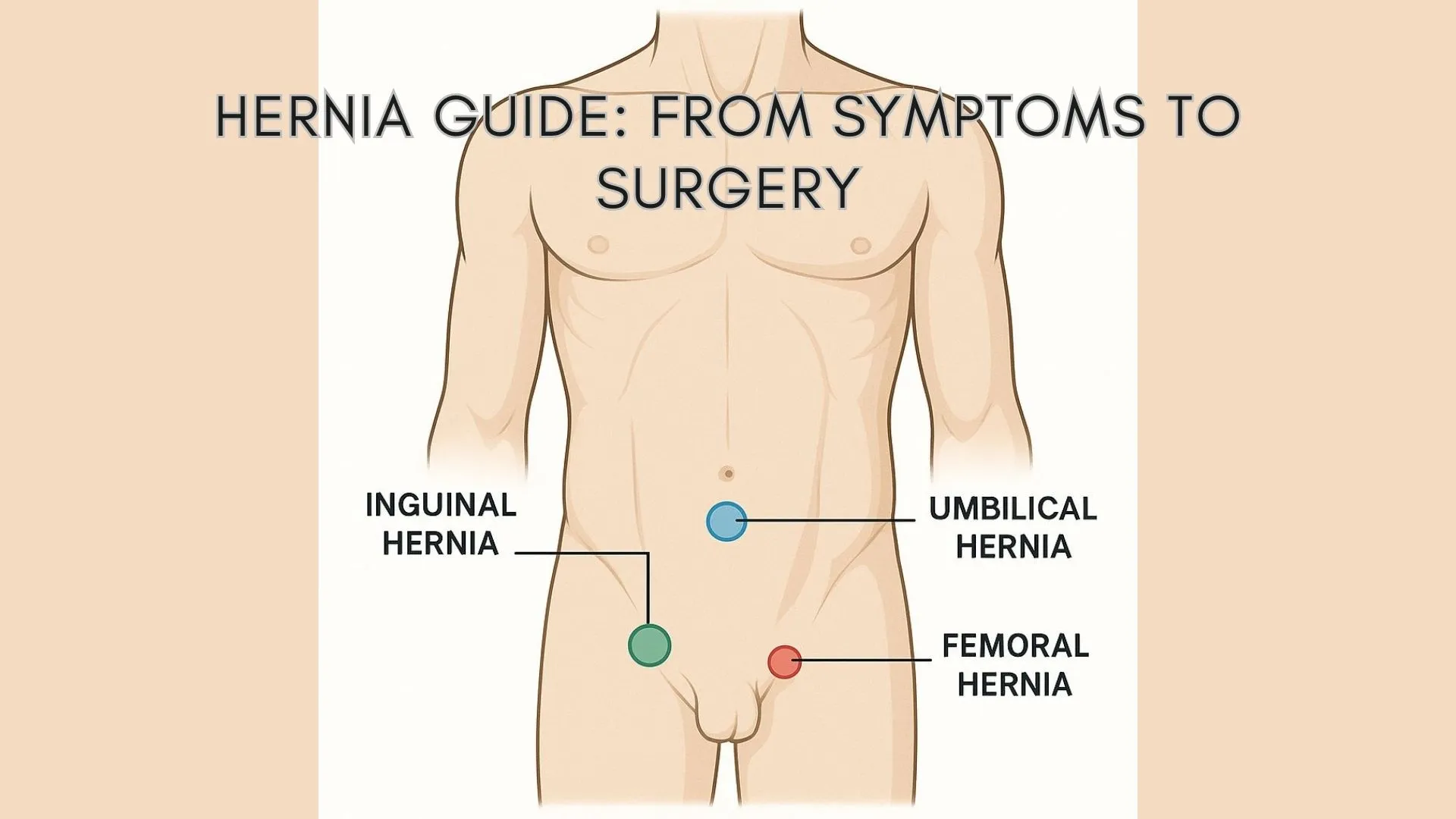Last updated: August 2025 | Reading time: 8 minutes
Understanding Hernias: Beyond the Basics
What exactly is a hernia? Think of your abdominal wall like a strong fabric. Over time, if a spot weakens due to age, strain, or injury, the inner contents might push through, creating what we call a hernia.
Table of Contents
- Understanding Hernias: Beyond the Basics
- Types of Hernias: Know Your Risk
- Recognising Symptoms Early
- Advanced Diagnosis Methods
- Modern Treatment Options
- Recovery and Prevention
- When to See a Doctor Immediately
- Frequently Asked Questions
A hernia occurs when part of an organ (typically intestine) or fatty tissue pushes through a weak spot in the surrounding muscle or tissue wall, resulting in a noticeable bulge. While it can develop anywhere in the body, they most commonly appear in the abdomen and groin areas.
Recent Statistics That Matter
According to 2024 medical research:
• Global prevalence: 15-20% of the population develops hernias
• India-specific data: 1.5-2 million inguinal hernias occur annually
• Gender distribution: Men are 5-10 times more likely to develop inguinal hernias
• Age factor: Risk increases significantly after age 45, affecting 4% of this population
The Hidden Impact
Recent studies show that 63% of patients still experience symptoms three years after the repair, emphasizing the importance of early detection and proper treatment.
Types of Hernias: Know Your Risk
Most Common Types
- Inguinal (80% of all hernias)
• Location: Groin area
• Who’s affected: Predominantly males (90% of repairs)
• Symptoms: Bulge in groin, pain when lifting or coughing - Femoral
• Location: Upper thigh/groin
• Who’s affected: More common in females (70% of femoral repairs)
• Risk factor: Higher chance of complications due to narrow opening - Umbilical
• Location: Near belly button
• Who’s affected: Common in infants, adults post-pregnancy, or after abdominal surgery
• Appearance: Visible bulge around navel - Incisional
• Location: Previous surgical scars
• Statistics: 14.7% incidence rate after emergency surgeries
• Risk factors: Obesity, diabetes, smoking
Less Common But Important Types
• Hiatal Hernia: Stomach pushes through diaphragm (causes acid reflux)
• Epigastric Hernia: Upper abdomen between navel and breastbone
• Spigelian Hernia: Rare lateral abdominal wall hernia
Recognizing Symptoms Early {#recognizing-symptoms} Primary Warning Signs
Recognising Symptoms- Early Primary Warning Signs
Visible symptoms:
• Noticeable bulge that may disappear when lying down
• Swelling that increases with coughing, straining, or standing
Physical sensations:
• Dull ache or sharp pain, especially during physical activity
• Feeling of heaviness or pressure in the affected area
• Burning or aching sensation
• Discomfort when bending, lifting, or coughing
Hiatal Hernia Specific Symptoms
• Persistent heartburn
• Chest pain
• Difficulty swallowing
• Acid reflux that worsens when lying down
Red Alert: Emergency Symptoms:
Seek immediate medical attention if you experience:
• Sudden, severe pain
• Hard, non-reducible bulge
• Nausea and vomiting
• Inability to pass stool or gas
• Bulge becomes red, purple, or dark in color
These symptoms may indicate strangulation, a medical emergency requiring immediate surgery.
Advanced Diagnosis Methods
Modern Diagnostic Approach
Physical Examination:
• Standing examination while coughing or straining
• Palpation to detect bulges or weakness
• Assessment of pain levels and reducibility
Advanced Imaging:
• High-definition ultrasound: 95% accuracy rate
• CT scans: Best for complex cases and surgical planning
• MRI: Reserved for difficult-to-diagnose cases
Why Early Diagnosis Matters
Recent research indicates that early intervention prevents complications and reduces recovery time from 6 weeks to 2-3 weeks with modern techniques.
Modern Treatment Options
- Enhanced Mesh Technology
• Biocompatible materials reducing rejection risk
• Self-fixating meshes eliminating need for sutures
• Absorbable meshes for temporary reinforcement - Minimally Invasive Techniques
• Laparoscopic repair: 3-5 small incisions
• Extended Totally Extraperitoneal (eTEP): Latest technique with excellent outcomes
• Transabdominal Preperitoneal (TAPP): Gold standard for bilateral hernias
Treatment Selection Based on Types
Type Recommended Approach Success Rate Recovery Time
Small Inguinal (<4cm) Laparoscopic/Robotic 98% 1-2 weeks Large Inguinal (>4cm) Open mesh repair 95% 3-4 weeks
Umbilical Laparoscopic IPOM 97% 2-3 weeks
Incisional Robotic eTEP 94% 2-4 weeks
Hiatal Laparoscopic fundoplication 90% 3-6 weeks - Robotic-Assisted Surgery
• Success rate: 98% with minimal complications
• Recovery time: 50% faster than traditional open surgery
• Hospital stay: Same-day discharge in 90% of cases
• Latest systems: Da Vinci, Senhance, and new Dexter robotic platforms.
Watchful Waiting: When Surgery Can Wait
Suitable candidates:
• Small, painless hernias
• Elderly patients with significant medical risks
• Hernias that reduce easily
Monitoring requirements:
• Regular follow-ups every 6 months
• Immediate consultation if symptoms worsen
Recovery and Prevention {#recovery-prevention}
What to Expect During Recovery
First 24-48 Hours:
• Mild to moderate pain (normal)
• Restricted movement
• Same-day discharge for laparoscopic procedures
Week 1-2:
• Gradual return to light activities
• Showering permitted after 48 hours
• Office work resumption possible
Week 3-6:
• Full activity restoration
• Heavy lifting clearance (>15 lbs)
• Complete healing achieved
Recovery Tips
- Pain Management: Take prescribed medications as directed
- Activity Progression: Start with walking, gradually increase intensity
- Wound Care: Keep incision dry and clean
- Dietary Considerations: High-fiber diet prevents constipation
- Follow-up Compliance: Attend all scheduled appointments
Prevention Strategies That Work
Lifestyle Modifications:
• Maintain healthy BMI (reduces risk by 40%)
• Proper lifting techniques (bend knees, not back)
• Regular core strengthening exercises
• Smoking cessation (improves tissue healing)
Medical Management:
• Treat chronic cough promptly
• Manage constipation effectively
• Control diabetes (reduces complications by 30%)
When to See a Doctor Immediately
Don’t Delay: Urgent Consultation Needed
New bulge or swelling: Any new abdominal or groin bulge requires evaluation
Increasing pain: Progressive pain that interferes with daily activities
Changes in bowel habits: Constipation, inability to pass gas
Associated symptoms: Fever, nausea, vomiting
Emergency Room Situations
• Incarcerated hernia: Cannot push bulge back in
• Strangulated hernia: Severe pain with nausea/vomiting
• Bowel obstruction: Inability to pass stool or gas for 24+ hours
Choosing the Right Specialist
General Surgeon: Standard hernia repairs
Hernia Specialist: Complex or recurrent hernias
Minimally Invasive Surgeon: Laparoscopic procedures
Frequently Asked Questions
Q: Will my hernia heal by itself?
A: No. it never heal spontaneously and typically worsen over time without treatment.
Q: How long before I can exercise after surgery?
A: Light walking immediately, gym workouts after 2-3 weeks, heavy lifting after 6 weeks (with surgeon approval).
Q: What’s the difference between open and laparoscopic surgery?
A: Laparoscopic uses small incisions with faster recovery (2-3 weeks vs 6-8 weeks), less pain, and better cosmetic results.
Q: Can hernias recur after surgery?
A: Modern mesh repairs have recurrence rates under 2%. Proper technique and post-operative care are crucial.
Q: Is robotic surgery worth the extra cost?
A: Studies show 30% faster recovery, reduced pain, and better precision, making it cost-effective for complex cases.
Q: Are there any dietary restrictions after surgery?
A: No specific restrictions, but high-fiber foods help prevent constipation during recovery.
Latest Research and Future Directions
Emerging Treatments (2024-2025)
• Bioengineered meshes: Growing patient’s own tissue for repairs
• AI-assisted surgery: Improved precision and outcome prediction
• Gene therapy: Targeting genetic factors in development
Prevention Research
• Genetic markers: Identifying high-risk individuals
• Preventive exercises: Specific core strengthening protocols
• Lifestyle interventions: Evidence-based prevention strategies
Take Action for Your Health
Your Next Steps
- Self-assessment: Check for bulges during coughing or straining
- Documentation: Photo-document any bulges for doctor consultation
- Medical history: Compile family history and risk factors
- Consultation: Schedule evaluation if you suspect it.
Read More Blogs: What You Should Know About Hernias
Disclaimer
This content has been reviewed by general surgeons and is based on the latest medical literature and clinical guidelines. Information is for educational purposes and should not replace professional medical advice.
Contact Information
For more such blogs stay tuned
Read Our Blogs: Shoulder Pain: Causes, Symptoms, and What You Can Do ?

